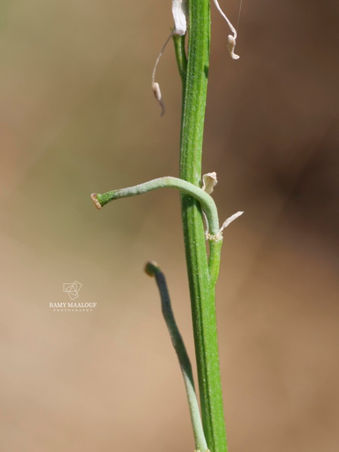Family |
Brassicaceae
Erysimum scabrum
DC.
Erysimum scabrum DC.
(Syst. Nat. 2: 505; 1821 – Nouvelle Flore du Liban et de la Syrie, vol. 2, Pl. CX nº 3; 1969)
• Life-form & habit: Biennial or short-lived perennial herb, 20–60 cm tall, erect and usually much-branched above. Stems rigid, angular, grey-green, covered with short, appressed, forked hairs giving a scabrid texture.
• Leaves: Basal leaves forming a loose rosette, oblong-lanceolate, 4–10 × 1–2 cm, entire or obscurely toothed, narrowed into a short petiole; cauline leaves alternate, linear-lanceolate, sessile, greyish, and densely pubescent.
• Inflorescence & flowers: Raceme elongating in fruit, many-flowered. Flowers bright yellow to orange-yellow, 12–15 mm across; sepals erect, greenish, 5–6 mm long; petals obovate, 10–12 mm long, limb broad, apex rounded, clawed at base. Stamens 6, tetradynamous; filaments and anthers glabrous; stigma small, entire.
• Fruit: Silique linear, 3–5 cm long, slightly compressed, straight or slightly curved, appressed to the rachis, densely covered with minute, rough hairs; valves with faint veins. Seeds numerous, oblong, c. 1.5 mm, pale brown.
• Phenology: Flowers and fruits from March to June.
• Habitat & elevation: Dry stony slopes, steppe grasslands, and open pine or juniper woodlands, 600–1 800 m; prefers calcareous soils and exposed, sunlit habitats.
• Lebanese distribution: Reported by Mouterde from Mount Lebanon and the Beqaa Valley, especially Barouk, Dahr el-Baïdar, and Ras Baalbeck; characteristic of dry montane and subalpine limestone terrain.
• Native to: Iran, Lebanon-Syria, Palestine, Türkiye (POWO).
• ⚠️ Taxonomic note: Erysimum scabrum is a Levantine–Irano-Anatolian mustard readily distinguished by its greyish indumentum of appressed, bifid hairs, bright yellow flowers, and slender, rough siliques. Mouterde (1969) noted its resemblance to E. cuspidatum but separated it by its shorter, scabrid pubescence and less erect habit. In Lebanon, it is a characteristic spring species of dry montane slopes and limestone ridges, often flowering en masse after snowmelt.










